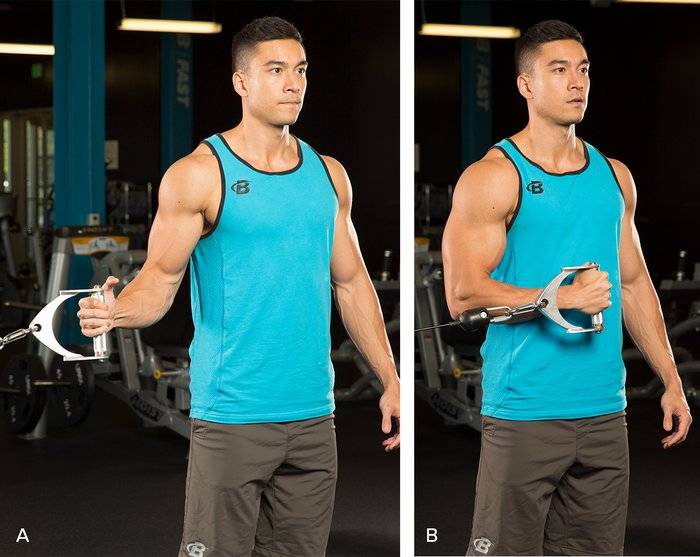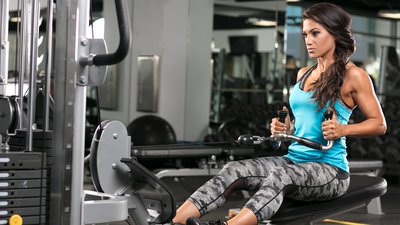It's the fundamental posture of our times—and that's not a good thing. Sitting in our cars, at our desks at work, on our couch, and especially staring at a phone, all drag us down into an exaggerated position where the thoracic spine is slumped or flexed. And sooner or later, it becomes our default position—known as "kyphosis."
Flexing the spine itself isn't a bad thing—it's a function of the spine for a reason and we wouldn't be able to go there so easily if it wasn't. But that doesn't mean it's healthy for you to hang out in that position for hours every day.
In some cases, this is something certain people are susceptible to more than others due to their bone structure and possibly their genetics. But in many cases, the things we do in and out of the gym can amplify its effects.
Here's how to fight back against the hunchback—and beat it!
A Few Details on Kyphosis
Kyphosis affects the thoracic spine, which is the upper and middle back, and causes a rounded posture. Most people think that it only affects the spine, but this change in spinal shape has a big impact on the rest of the back and ribcage, too. The position of the scapulae, or shoulder blades, on a thoracic spine and ribcage under kyphosis will definitely shift, pushing them higher and outward into an ever-more dysfunctional "winged" position. Along with this change, the front side of the body often becomes chronically short and tight due to the closed ribcage position and protracted shoulders. This can contribute to shoulder pain, among other problems that plague lifters.
You aren't going to defeat this foe by accident. You'll need a proper and strategic plan of action when attacking and fixing kyphosis.
Step 1: Attack the Lower Traps
Many people forget that the traps aren't just there to elevate the shoulders, the way they do when gym bros strap up and hit the 100-pound dumbbells for sets of shrugs. They also depress the shoulders and play an important role in perfecting good posture, not only when you're standing, but also when you're doing important lifts like front squats and pull-ups.
The problem is, most people neglect the part of the traps responsible for this—the lower traps. These fibers contract downward, and they have an important role in keeping the front of the ribcage in a strong, open position. The following two exercises are a perfect plan of attack to get them lit up.
Trap 3 Raise: The trap 3 raise narrows things down to each individual side and makes the traps work hard to lever the arm upward. It doesn't take much weight to make the muscles work hard, and it will likely take a few practice reps to get the hang of it. Remember to retract the shoulder blade before each rep, the way I do in the video.
Kettlebell Angled Press: This is another way to get the traps in relative isolation without having to worry about other muscle groups kicking in. Using a light kettlebell, make an attempt to never let it travel toward the ground, and rather "slide" from chest level to full extension. The force angle will hit the lower traps hard while minimizing deltoid involvement.
Step 2: Dial Back the Front-Side Work
I'm not saying that everything you do for the front side of the body will completely sabotage what we're going for, but when you're trying to improve posture, avoid overdoing specific movements like rectus abdominis training, pull-overs, and even some lat work, since the lats are internal rotators of the shoulder.
There's a certain logic that exercises like pull-overs or hanging leg raises have a "stretch" component that forces the thoracic spine to extend, but I'd answer that this stretch is more or less negated in the moves, because the muscles have to contract under load to reverse that position.

If you really want to open up the thoracic spine, focus instead on exercises like foam-roller extensions to train the thoracic spine to feel extension—and only extension.
To do it, simply lay a foam roller on the floor and lie on it face up so that it goes widthwise across your back, just below the shoulder blades. Keep your butt planted on the floor and your knees bent. Nest your head in your hands by linking your fingers behind your head, and simply try to make your shoulders "wrap" around the roller. Just ensure you keep your butt planted to do it.
Repeat this motion for reps, and take it slow. Remember, this is a stretch more than anything else.
Step 3: Ditch the Pull-Ups for a While
The tough thing about back training is that people think that any back exercise is a good one, where postural correction is concerned. The logic is tempting: Strengthen the upper back, open up the front side, and push the volume through the roof. What could go wrong?
In good intention, people will double up on their pulling movements, which can include pull-ups and chin-ups, reasoning that they're premier strengthening exercises that also have a huge positive impact on posture.
In most cases, they'd be right, but when someone's spine is chronically flexed to the point of kyphosis, pull-ups aren't the best choice. The truth is, when someone has the "winged" scapular position typical of a hunched posture, they'll also have an incomplete range of motion for the arm at the shoulder joint. Reaching overhead for any movement will result in compensation, usually at the lower back.
Forcing the arms into a dead hang position under a pull-up bar may seem like a good way to build range of motion, but in reality, it's a huge compromise to shoulder health for an immobile lifter.
Once you spend some quality time with foam-roller extensions and lower-trap work, pull-ups may someday come back on the menu. But until then, focus on horizontal rows to keep the shoulder joint in a good position while it bears load. Depending on the pattern, you'll still do a lot to hit the lats, as well as many other scapular muscles under safer conditions.
As your upper-back strength becomes more restored, gently incorporate mobility and flexibility drills like shoulder dislocates and chest stretches into the mix, so that you can attack the problem from both sides.
Oh, and stop hunching over while texting. Instead, use that voice-to-text feature to let me know in the comments how this works for you!

